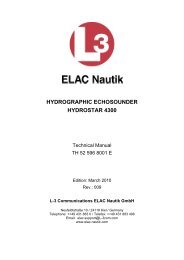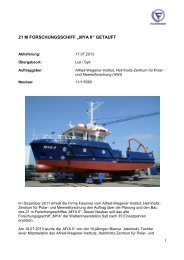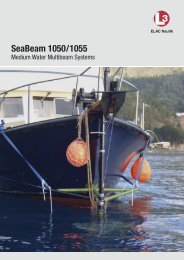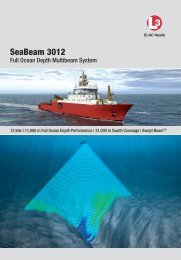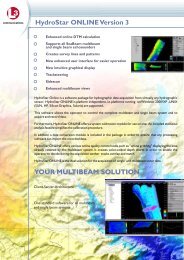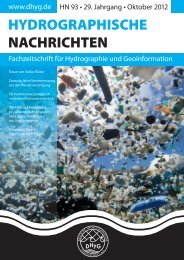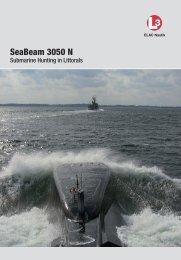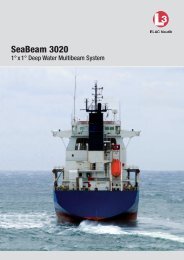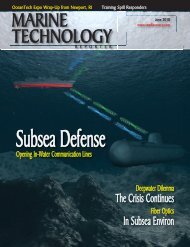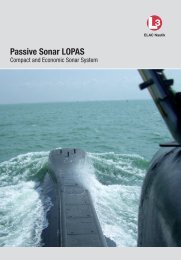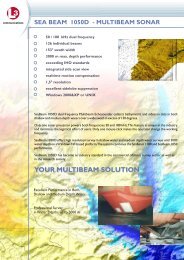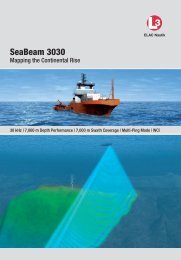SeaBeam 3050 - Elac-Nautik
SeaBeam 3050 - Elac-Nautik
SeaBeam 3050 - Elac-Nautik
Create successful ePaper yourself
Turn your PDF publications into a flip-book with our unique Google optimized e-Paper software.
DISCOVER THE UNKNOWN<br />
<strong>SeaBeam</strong> <strong>3050</strong><br />
Medium Depth Multibeam System<br />
The <strong>SeaBeam</strong> <strong>3050</strong> multibeam echo sounder collects bathymetric, corrected backscatter, sidescan and<br />
Water Column Imaging (WCI) data in medium depth over a wide swath in excess of 140 degrees, meeting all<br />
relevant survey standards. Due to its depth performance in combination with wide coverage, <strong>SeaBeam</strong> <strong>3050</strong><br />
is the ideal hydrographic sensor for mapping the continental slope.<br />
Multi-Ping Technique<br />
A big advantage of the <strong>SeaBeam</strong> <strong>3050</strong> is the new multiping<br />
technique. The system compensates fully for vessel<br />
roll, pitch and yaw motion and transmits and processes<br />
two swaths in one ping. Bathymetric depth information,<br />
amplitude (backscatter) data, WCI data and side scan<br />
imagery are acquired by the system in real-time.<br />
The new multi-ping technique allows a higher maximum<br />
survey speed without losing 100% bottom coverage by<br />
creating two swaths per ping cycle, which is important<br />
especially for narrow along-ship beam widths.<br />
For 1° along-ship resolution and 140° swath width<br />
<strong>SeaBeam</strong> <strong>3050</strong> allows for a survey speed of more than<br />
14 knots. On the other hand, at the same survey speed<br />
a bottom segment is ensonifi ed two times more often<br />
than using a single-ping mode.<br />
post-processing with modern processing methodologies like CUBE and enhances<br />
the quality of the fi nal products.<br />
Performance<br />
The system operates in the 50 kHz frequency band in water depths ranging from<br />
3 m below the transducers to approx. 3,000 m. <strong>SeaBeam</strong> <strong>3050</strong> can be utilized at<br />
survey speeds of up to 14 knots. It has an across-ship swath width of up to 140<br />
degrees. A maximum of 630 beams is provided for each multiping. The depth<br />
accuracy of the sonar sensor exceeds the IHO requirements.<br />
Transmission Technique<br />
<strong>SeaBeam</strong> <strong>3050</strong> uses a transmission technique, which compensates fully for vessel<br />
pitch and yaw motion. This is achieved by splitting the transmit fan in several<br />
sectors which can be steered individually. This technique achieves full motion<br />
compensation and guarantees a stable straight coverage under the vessel.<br />
The result is a higher data density at the same survey<br />
speed. This increases the target detection and classifi -<br />
cation abilities. A high data density is advantageous for<br />
Key Features<br />
Up to 3,000 m Depth Performance<br />
Up to 3,500 m Bottom Coverage<br />
Multi-Ping Mode<br />
Real-time Water Column Imaging (WCI)<br />
Mobile Version for up to 1.5° x 2° Beam Width<br />
optional:<br />
Transducers adapted to Specific Ship's Hull<br />
<strong>SeaBeam</strong> <strong>3050</strong> multibeam system<br />
2



